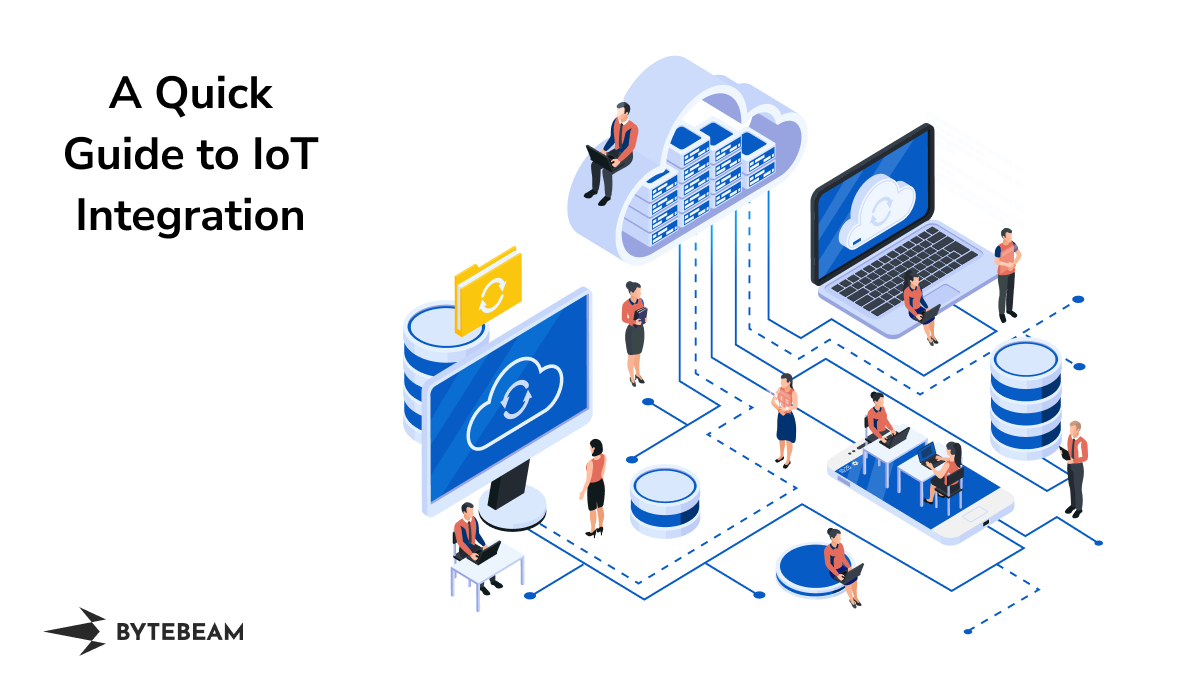A Quick Guide to IoT Integration

The number of IoT devices has already surpassed the number of people on the planet.
We are at a stage where IoT devices now need to be grouped in order to make them function easily. Right from personal devices such as smartphones and smartwatches to industrial devices like sensors and factory equipment, all devices need to be able to work together for them to make sense.
These devices working together are improving efficiency and productivity like never before. But at the same time, this integration needs to be handled carefully.
What to expect: In this guide, we will explain what IoT integration is, why it is important, and how to pick an integration service that can help you reduce the complexity that comes with several IoT devices.
What is IoT Integration?
Internet of Things is a concept where everyday objects like refrigerators, cars, or even your light bulbs can connect to the internet and communicate with each other and with us. IoT enables your refrigerator to send you a message letting you know when you're low on milk, or your light bulbs to turn themselves off when they sense you've left the room.
IoT integration is about getting all these different devices to work together in a coordinated way like a team sport. Each individual player (or in this case, device) is good at something different, but they need to work together to achieve a common goal.
For example, when you're going to bed, you could manually turn off all the lights, check the doors are locked, adjust the thermostat, and so on. But with IoT integration, you might just tell your smart speaker "Goodnight," and it will communicate with all the other connected devices in your house to make sure everything is set for the night - lights off, doors locked, and temperature adjusted.
Doing this requires some behind-the-scenes work, like setting up the devices to connect to your home network and making sure they can "talk" to each other in a language they all understand. It can also involve setting up rules or "routines" (like the "Goodnight" command) so that the devices know what to do in different situations.
Basically, IoT integration is about getting all of your internet-connected devices to work together smoothly and efficiently, to make your life easier and more convenient.
Examples of IoT integration
Here are some real-world examples of IoT integration in action:
Smart Homes
One of the most well-known applications of IoT integration is in smart homes. For example, products like Amazon Echo or Google Home integrate various IoT devices such as smart lights, smart thermostats, and smart locks into a single system that can be controlled through voice commands or via an app. For instance, with proper integration, you can tell your smart speaker to "start movie night", and it could dim the lights, turn on the TV, and even order your favorite pizza.
Industrial IoT (IIoT)
In industries, IoT integration is used to connect various devices and machines on the factory floor. For example, General Electric has developed Predix, an industrial IoT platform that integrates and analyzes data from different machines and systems to optimize operations, reduce downtime, and improve overall efficiency.
Healthcare
IoT integration is also transforming healthcare. Devices like heart monitors, insulin pumps, and even fitness trackers can all be connected to create a holistic picture of a patient's health. Philips HealthSuite is an example of an IoT platform that integrates data from various medical devices to provide more personalized and efficient care.
Smart Cities
IoT integration is essential in the development of smart cities. For instance, in Barcelona, different IoT devices have been integrated to manage things like traffic, waste management, street lighting, and water management. Sensors collect data, and this data is then analyzed and used to improve services and reduce costs.
Agriculture
In the agricultural sector, IoT integration can help manage different aspects of farming more effectively. John Deere, for example, has created a connected farm solution that integrates data from various sources such as weather stations, soil sensors, and equipment to optimize farming practices
These are just a few examples. The possibilities for IoT integration are vast and growing every day as more devices become internet-enabled and more uses are found for the data they produce.
Importance of IoT Integration
IoT integration is important for several reasons:
Efficiency and Automation: IoT integration allows various devices to work together and automate tasks, creating more efficiency. For example, a smart thermostat can adjust the temperature based on whether or not people are detected in the house, saving on energy costs.
Convenience: IoT integration makes it easy to manage multiple devices from one central point, often an app on a smartphone or a hub device. This provides convenience because instead of having to individually manage each device, you can control them all in one place.
Data Collection and Analysis: Integrated IoT devices can collect data from various sources, providing insights into trends and patterns. For example, a fitness tracker can integrate with a diet app and sleep monitor to provide a holistic view of health. This data can help in making informed decisions.
Enhanced Decision-Making: With the ability to gather and analyze large amounts of data, IoT can provide valuable insights for decision-making in various fields, including healthcare, agriculture, manufacturing, and more.
Safety and Security: IoT integration can enhance safety and security. For instance, smart security systems can include door sensors, cameras, and smart locks that all communicate with each other to provide a comprehensive security solution.
Improved Quality of Life: In healthcare and elderly care, IoT integration can be very beneficial. Devices like fall detectors, medication reminders, and remote health monitoring devices can help provide better care and independence for seniors.
Sustainability: IoT can play a significant role in environmental sustainability. Smart homes and buildings can reduce energy consumption, and smart agriculture can optimize resource use.
In essence, IoT integration can lead to significant improvements in convenience, safety, decision-making, and efficiency in various areas of life and business. It forms the backbone of smart homes, smart cities, and Industry 4.0, among others.
How to choose an IoT integration service
An IoT integration service helps you get all of your different IoT devices working together. They provide the software and sometimes hardware that act as a sort of translator or middleman between your devices, allowing them to understand each other and work together.
For example, let's say you have a smart thermostat from Amazon and a smart lighting system from Google. These devices may not naturally be able to communicate with each other because they were made by different companies with different systems. An IoT integration service can provide a solution that allows these two devices to talk to each other. So, if you want your lights to dim when you lower the temperature on your thermostat, an IoT integration service can make that happen.
Moreover, IoT integration services can also help with data management, security, and updates for your IoT devices, ensuring they work efficiently and securely.
Choosing the right IoT integration service involves several factors, and it depends on your specific needs and constraints. Here are some important aspects to consider:
- Compatibility: The integration service should be compatible with your existing and planned IoT devices. Some platforms might not support all devices or protocols, so it's crucial to check this first.
- Scalability: If you're planning on adding more devices or expanding the system's functionalities in the future, you'll want to choose a service that can scale with your needs.
- Security: Security is a major concern in IoT due to the potentially sensitive data that these devices handle. The service provider should offer robust security measures to protect your devices and data.
- Ease of Use: The platform should be user-friendly, allowing for easy setup, management, and troubleshooting of your IoT devices.
- Reliability: Look for a provider with a track record of reliable service. You don't want your system to go down because the integration service is experiencing problems.
- Support and Maintenance: Check if the service provider offers technical support, regular updates, and maintenance to keep the system running smoothly.
- Cost: Consider the cost of the service, including initial setup cost and ongoing fees. Some services may require a large upfront investment, while others may be more affordable but have higher ongoing costs.
- Data Management Capabilities: If your IoT system will be generating a lot of data, you'll need an integration service with strong data management capabilities. This includes data storage, processing, analytics, and reporting features.
- Interoperability: The IoT ecosystem is diverse with many different standards, protocols, and device types. The integration platform should be able to support this diversity and ensure seamless interoperability among devices.
- Vendor's Reputation: Check the reputation of the vendor in the market. Look for reviews or case studies that may give you an idea about the reliability and performance of their service.
The right IoT integration service for you will depend on your specific needs, the devices you're using, your technical capabilities, and your budget. It's a good idea to do some research and perhaps even speak with a consultant or expert before making a decision.
Wrapping up
IoT integration has wide applications in the real world, from smart homes where you can control all your devices through a single app or voice command, to industries where machinery and systems are connected to improve efficiency. It's also being used in healthcare for patient monitoring, in cities for better resource management, and in agriculture for optimizing farming practices.
As technology advances, we can expect to see even more applications of IoT integration, making our devices more efficient, our data more useful, and our lives more convenient. The possibilities are vast and exciting.
This article is a part of our IoT basics series where we explain some basic concepts of Internet of Things. If you would like to learn more, subscribe to our blog!

